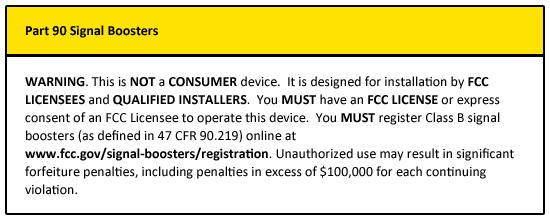Part 90 Signal Boosters are a type of Industrial Signal Booster. Part 90 Signal Boosters sold and marketed starting on March 1, 2014 must meet new FCC requirements. In addition, Class B Signal Boosters must be registered directly with the FCC before being used.
Register Your Part-90 Class B Signal Booster
On February 20, 2013, the FCC released a Report and Order that included the following actions related to Part 90 Signal Boosters:
- Clarification of FCC rules to make it clear that non-licensees who seek to operate signal boosters must obtain the consent of the licensee[s] whose signals they intend to amplify;
- Adoption of a registration requirement for existing and future Class B signal booster installations;
- Permit Part 90 licensees to deploy Class A (narrowband) signal boosters in both fixed and mobile environments provided that they do not cause interference to other licensed services in the band. Prohibit mobile deployment of Class B (wideband) signal boosters, but allow fixed deployment of Class B signal boosters;
- Require system integrators and installers to consider the potential adverse effects of the increased noise floor on PLMR systems and establish additional emission limits to reduce the interference potential of signal boosters;
- Update the FCC equipment authorization process to differentiate between Class A and Class B signal boosters and testing procedures;
- Establish labeling requirements to promote compliance with FCC rules; and
- Clarify certain definitions and power requirements.
Several of these changes are highlighted below with additional information.
Part 90 Signal Booster Classifications
Class A signal booster. A signal booster designed to retransmit signals on one or more specific channels. A signal booster is deemed to be a Class A signal booster if none of its passbands exceed 75 kHz.
Class B signal booster. A signal booster designed to retransmit any signals within a wide frequency band. A signal booster is deemed to be a Class B signal booster if it has a passband that exceeds 75 kHz.
Registration System for Class B Signal Boosters
On February 20, 2013, the FCC released a Report and Order that included a requirement for new and existing Class B signal boosters to be registered with the FCC. By creating a permanent record of all Class B signal booster installations in a searchable database, licensees will be able to search online for signal booster installations if they experience interference or other degradations to their system. This will allow licensees to identify and shut down signal boosters causing harmful interference as necessary.
Licensees and signal booster operators were required to register existing Class B signal booster installations with the FCC by November 1, 2014. After November 1, 2014, operation of an existing, unregistered Class B signal booster is unauthorized and subject to enforcement action. Any new Class B signal booster installed after November 1, 2014 must be registered prior to operation. To encourage compliance with this new requirement, registration will be free of cost to the operator and/or licensee.
Manufacturers and Labeling Requirements
As of February 20, 2013, the FCC will no longer accept applications for equipment certification for Part 90 Signal Boosters that do not comply with the FCC’s new rules. In addition, the FCC will cease certification of devices which do not comply with the new rules. As of March 1, 2014, all Industrial Signal Boosters sold and marketed in the United States must meet the FCC’s new rules.
Transition Process
The FCC established a two-step transition process for equipment certification for Part 90 Signal Boosters sold and marketed in the United States.
Labeling Requirements
Part 90 Signal Boosters must include a label with the following information:
- As of February 20, 2013, the FCC will no longer accept applications for equipment certification for Part 90 Signal Boosters that do not comply with the FCC’s new rules. In addition, the FCC will cease certification of devices which do not comply with the new rules.
- As of March 1, 2014, all Industrial Signal Boosters sold and marketed in the United States must meet the FCC’s new rules.
It is possible that the warning label looks different than the sample label below. However, the warning label must include the same information.
